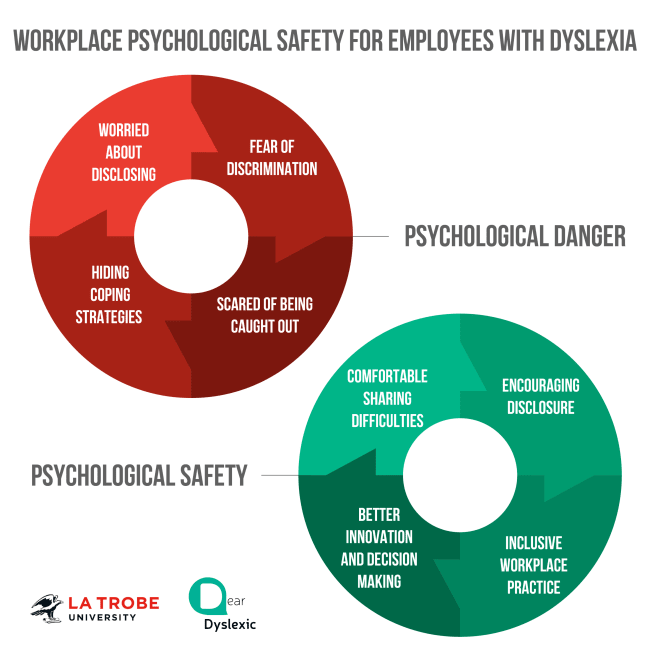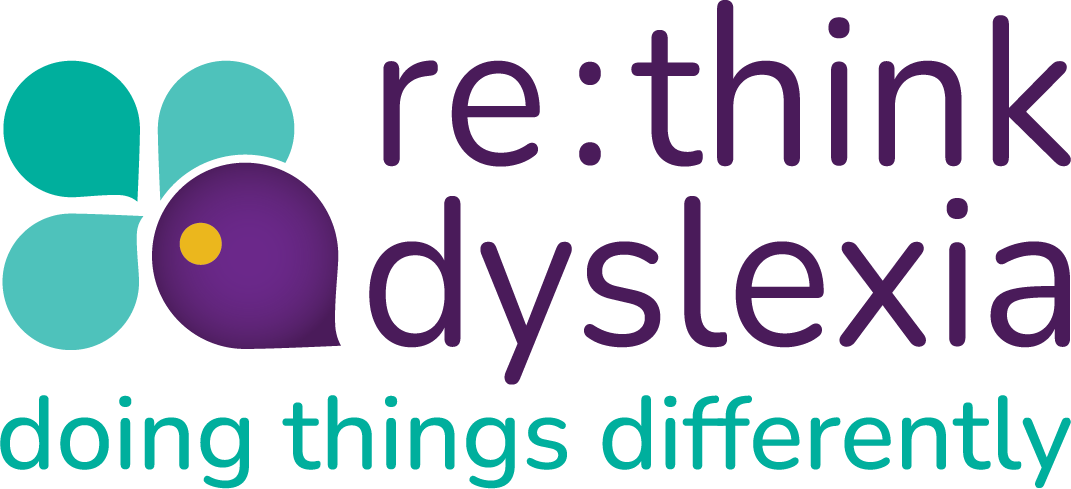Employment is crucial in allowing us to participate meaningfully in society. Our quality of life at work can be affected by organisational systems and processes, team dynamics, relationships with our supervisor, workplace culture, and inclusion. For employees with dyslexia, the working environment can be a difficult one to navigate.
Dyslexia is a type of learning disability that affects a person’s reading, writing, and/or maths skills [1, 2]. Around 1 in 10 people globally have dyslexia [3, 4]. In fact, did you know that right now in your organisation you will likely be working with or managing someone who has dyslexia? Most people in Australian organisations are not aware of that, and that’s ok, we are here to help. Our organisation exists to support you – the colleague, manager, leader and/or employer – by raising your awareness and skills to identify and help employees with dyslexia.
Dyslexia is known as a hidden disability [5]. You can’t see it, you can’t tell by looking at a person, but you may have noticed it without realising. Employees with dyslexia may send emails with a lot of grammar and spelling mistakes, it may take them extra time to complete tasks compared to peers or to read text, their days may appear disorganised, they may struggle with background noise, or they may respond better to learning by listening, observing and doing rather than reading [6].
To you as the colleague or manager,it may appear that your employee is being lazy, rushing work, taking too much time to complete work, has poor attention to detail or is just not performing to the standard you would expect. But what you may not know is that behind the scenes, your employee is likely to be using a number of their own personal (often ingenious!) problem-solving strategies to try to compensate for the challenges caused by dyslexia. Often, employees with dyslexia will work a lot harder than their colleagues just to keep up with their workload and to manage day-to-day tasks that appear very easy to others. They may work back late, skip lunch, or work nights and weekends just to keep up. And often, this will be causing them significant mental fatigue, leading to a constant state of exhaustion and eventually job burnout [6].
Why are they not asking for help, you may be asking. Well, many employees with dyslexia are too afraid to disclose their disability/difficulties to their manager. This is despite the fact that they are entitled by law to access reasonable adjustments to work demands under the Discrimination Act (1992) and Fair Work Act (2010) [7, 8].
We conducted research with La Trobe University to highlight the challenges of disclosing a disability like dyslexia in the workplace. Many employees feared being judged as different and therefore becoming vulnerable in the workplace; whether that was due to being stigmatised, viewed with pity, not taken seriously, or perceived as a weak link in the team [6]. Many employees have experienced what it is like to work in a psychologically unsafe working environment, where they didn’t feel comfortable seeking help.
“I would avoid [disclosure] because I don’t feel it would have a beneficial outcome. [I would be] exposing myself as [having a] weakness.”
So, what creates a psychologically unsafe work environment for employees with dyslexia where they feel they can’t disclose?
- Poor recruitment practices
- No awareness of dyslexia as a disability
- Lack of trust between colleagues, managers, and leaders
- Absence of inclusion and diversity policies and procedures
- Poor access to reasonable adjustments
- Intolerance for mistakes and/or mistakes that are publicly pointed out
- Working from a deficit rather than a strengths-based model
What can you do to ensure your workplace is psychologically safe?
- Provide dyslexia awareness training of dyslexia, particularly for managers and leaders
- Upskill managers, leaders and HR to better identify and support dyslexic employees
- Understand and improve reasonable workplace adjustments offered to employees with dyslexia
- Build trust and empathy amongst teams, managers and leaders
- Create space for employees to feel comfortable sharing difficulties in the workplace

A psychologically safe workplace is everyone’s business. It is important not just for dyslexic employee but for those with a range of difficulties, hidden disabilities and other differences. No one should feel fearful about going to work and everyone has the right to feel valued, respected and to be able to share their true authentic selves.
As an employer, you are in a powerful, influential position to lead by example by creating inclusive and diverse environments that are psychologically safe for all employees; environments where employees feel empowered to share their strengths and their difficulties. We all bring a unique set of skills to the workplace and by empowering rather than disempowering, we improve workplace culture, employee mental health and wellbeing and workplace productivity.
Build your skills and knowledge by accessing our Australian first workplace eLearning modules or book a 15-minute free consultation to see how we can work with you and your organisation to create inclusion for all.
Read our latest Australian-first research conducted in partnership with La Trobe University: “You Don’t Look Dyslexic”: Using the Job Demands—Resource Model of Burnout to Explore Employment Experiences of Australian Adults with Dyslexia Read here
This piece was written by our CEO Shae Wissell who is an executive contributor to Braniz Magazine
Executive Contributors at Brainz Magazine are handpicked and invited to contribute because of their knowledge and valuable insight within their area of expertise. Read exclusive articles from influential leaders, top entrepreneurs, expert coaches and industry leaders on the topics of mindset, business, leadership and lifestyle.
References:
- Lyon, G., S. Shaywitz, and B. Shaywitz, A definition of dyslexia. An Interdisciplinary Journal of The International Dyslexia Association, 2003. 53(1): p. 1-14.
- Snowling, M.J., C. Hulme, and K. Nation, Defining and understanding dyslexia: past, present and future. Oxf Rev Educ, 2020. 46(4): p. 501-513.
- Yang, L., et al., Prevalence of Developmental Dyslexia in Primary School Children: A Systematic Review and Meta-Analysis. Brain Sci, 2022. 12(2): p. 240.
- Tunmer, W. and K. Greaney, Defining Dyslexia. J Learn Disabil, 2010. 43(3): p. 229-243.
- Valeras, A., “We don’t have a box”: Understanding <em>Hidden Disability</em> Identity Utilizing Narrative Research Methodology. Disability Studies Quarterly, 2010. 30(3/4).
- Wissell, S., et al., “You Don’t Look Dyslexic”: Using the Job Demands-Resource Model of Burnout to Explore Employment Experiences of Australian Adults with Dyslexia. International Journal of Environmental Research and Public Health, 2022. 19(17): p. 10719.
- Australia, C.o., Fair Work Act in 28. 2009: Canberra. p. 585.
- Australia, C.o., Australia: Act No. 135 of 1992, Disability Discrimination Act 1992. 1992, National Legislative Bodies / National Authorities: Canberra.
